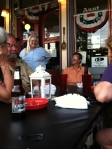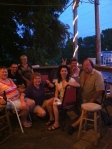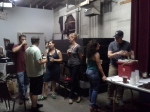Category: Blog Posts
I Know You Are But What Am I?
Last week, in preparation for our trip to New Orleans, Haymaker presented a draft of I Know You Are But What Am I to a small group of willing participants. Below, Akiva, Dan, and Emily share some reactions to that draft performance, and what they are excited to try during the two draft performances in New Orleans.
Akiva:
I hate audience participation.
Is a line I say in I Know You Are But What Am I.
But it’s in there because I feel it. For all the work I do breaking down divisions between performers and audience, for all the times I’ve made a play where an actor talks to an audience member or asks them to do something, I have to admit that most of the times when I’ve attended a show that wanted me to participate, I’ve pulled away. And I don’t think I’m alone in this opinion – I’ve seen people in our audiences (on this show, even) pull away when we ask them to join in.
So in the interest of full disclosure, “I hate audience participation” had to be a line in this show.
Maybe I shouldn’t be surprised, but very early on in the piece, I sit with the audience rather than staying at the front. It’s an “actor participation” show for me. I try to melt back into the audience and let myself become a passive observer again, a role that feels very easy for me. That’s my system for controlling complexity, a way to be a part of an interactive medium without interacting too much.
But every simplifying system in this show also confines. So my experience of being in this audience has been about giving up that system to try for a genuine interaction. My system is a lie from the beginning. When I tell them that I hate audience participation, I’m engaging in it. I don’t melt into the audience, I declare myself in it. I’m a hypocrite.
Still, when we “took off” at the end of our first performance of I Know You Are But What Am I, it felt like a release. I didn’t feel like a performer or a puppetmaster guiding an audience. I felt like part of a group experiencing a genuine interaction together.
I didn’t expect that. Maybe I was still falling back on actorly detachment. But it felt like something new to me.
Dan:
Sometimes I forget audience is not singular.
I blame rehearsal for this. It’s where I think of the audience as a herd. We’ll move them here…and then they’ll probably do this…and then they’ll grasp this idea, etc. At times, creating a performance can feel like a sociology experiment.
Last week, during our first full draft run of I Know You Are But What Am I, we’d agreed to try not having a formal greeting process as audience members arrived. So imagine no ticket taker, and no one to really acknowledge the arriving audience members as they came in the door.
The memory that comes to me is of a man arriving out of breath, slightly panicked, and looking desperately for someone. After a short time, I caved and introduced myself. He’d forgotten his ticket printout. He was apologetic and worried. He’d never been to something like this and didn’t know what to do. I assured him he’d done everything right so far, and then his face relaxed and his shoulders dropped. It was as if I’d dunked him in warm water.
I was reminded of how generous it is for someone to walk through that door. I was reminded of how much I want to reward them for coming, for taking that risk. I was reminded of just how much I appreciate that one person walks through the theater door and then another, and another, and so on.
Selfishly, I abandoned our agreement after that and then room changed for me. It seemed less like an audience or a group, and more like accumulation of persons. A weird perception trick, both singular and plural.
Emily:
I love people. Sometimes I hate them, sure – when they drive too slow or too fast, when they are in front of me in the grocery line, when they send me an email that is rude, when they say inflammatory things on the internet, when they vote anti-choice – you know, when they are inconsiderate. But for the most part, I love them. And when I’m not in a rush or unhappy or inconsiderate myself, I can see these annoyances as just part of humanity. A complicated, messy existence. We’re just all popping around doing our thing, banging into each other. Making mistakes, making people’s days, trying and failing to love and be love.
It’s why I like people watching. We get to be observers of this mixed-up world of people without any of the anxiety inherent in trying to deal with them. You get to see their humanity in its perfect complexity. You get to imagine stories about them, make judgments, and imagine what life would be like in their shoes or next to them.
There’s this part in I Know You Are But What Am I, where I get to sit and watch the audience. They are watching something behind my head – a video entitled “How to Make Flying Amazing.” The video is almost 10 minutes long, and I just sit there and watch them while they watch the screen. After Monday’s draft performance, it became my favorite part of the show. Watching them take in this video, each in their private way, reminded me of the ocean. Sitting there and watching the expressions change on their faces, I felt the individual responses – like the individual waves – becoming a tide of emotions washing over me. I was transported by them being transported. I felt love and loved. I can’t wait to do it again.
Learn more about I Know You Are But What Am I? on Haymakers blog.
A Reading Recommendation from PearlDamour
Check out this great article by Ron Berry posted on the National Performance Network. It talks about free theater and how it relates to building audiences. It’s awesome!
Going Free
by Ron Berry
For the past two and a half years, Fusebox Festival has been contemplating switching to a free festival model. There are obviously a host of issues and questions this decision brings up (both for our audiences and for the organization) as well as a host of emotions (from euphoria to sheer, face-melting terror). After researching various other free models around the country and talking to numerous colleagues and artists, we had our suspicions that we were onto something exciting but were still lacking some key evidence that could help cement board and donor buy-in.
Through the Mentorship and Leadership Initiative (MLI) process, we reached out to bestselling author Dan Heath to explore this potentially pivotal organizational change. Dan is a Senior Fellow at Duke University’s CASE center, which supports social entrepreneurs, and is the author of three best-selling books: Made to Stick (a book about ideas and why certain ideas stick and other don’t); Switch (a book about change and how it works — from changing your diet to large societal change); and his latest book Decisive (a book about decision-making). Dan also happens to be a longtime fan and supporter of the festival, so he had some significant context for our work, which we felt was important……..
That was just a taste, read more by following the link!
Traveling the Learning Curve
Over the last several months we’ve traveled a long slow curve towards understanding who our MILTON audience might be and how we want to build a relationship with them (both before, during, and after the show). We’ve moved towards understanding in a couple ways:
1. workshopping material to audiences of our peers
2. wrestling with the relationship between long term community engagement and the show itself
3. visiting the Milton communities, maintaining email contact, and starting to build partnerships for presenting the show in each town.
Workshop showings are, of course, always incredibly useful– especially when you get written feedback after. These were particularly great as we seek to get at the tone of the show. This piece is going to be a combination of speaking and singing, and also will have a combination of abstract imagistic text with more straightforward, linear text. Are we creating something that is both mysterious, interesting, and also accessible? Some useful feedback questions we asked were: “what were the points of entry (“doorways”) for you in the piece?” “were there times you felt shut out?” “what did you crave more of?”. We also are working with using objects from and photographs of each Milton, letting the audience handle these things and talk amongst themselves about them. There was a lot of enthusiasm about that idea, and cravings to have it pushed farther– mostly as a way to feel and create the community within the audience that the piece seems to be talking about.
We now say that this is a 3 part project: a live performance, a durational community engagement effort, and an interactive website. We are slowly sculpting the engagement plan to be something we can handle (it’s so easy to let it get way too big), and something that feels vital to us as artists and to the content of the piece. The umbrella term for this work “intimate encounter.” We are in the final stages of developing a new website that will really serve this goal of creating opportunity for engagement and encounter.
Emily shares a TED Talk and some thoughts
Visiting Milton, NC
On Saturday, Haymaker met up with PearlDamour in Milton, NC to get a first hand look of how Lisa & Katie are creating their new work.
- Meeting with residents of Milton, NC
- Everyone enjoyed some of Aunt Millie’s great pizza
- More new friends!
- Discussing the day so far (and thinking about ordering more pizza)
- Cheese! (on the pizza that is)
- Duchess – the neighborhood’s 3-legged mascot
Friday Night’s Triangle Theater Caring & Sharing Kegger
Friday night Haymaker threw a party to introduce our new friends, PearlDamour, to the Triangle (Raleigh/Durham/Chapel Hill) theater community! There was beer & snacks, plus “theater spoken word karaoke”. It was silly and fun and a great time to hang out and come together as a theater community.
- Sharing & Caring Kegger
- Mingling
- Theater Spoken Word Karaoke
- New friends and old
- No singing allowed!
- I Make Art For…
- Thoughts and inspirations from everyone present
Getting Ready for Day #2
A Welcome Note from PEARLDAMOUR
Hello Audience!
PearlDamour here. We met Haymaker when they volunteered (volunteered!) to be a part of our last project called How to Build a Forest when we toured it to Duke — they were a part of our “breathing composition”, composed by Brendan Connelly. We loved hanging out with them in rehearsal – and in the bar of the Durham Hilton, where our team was staying, and where we first started dreaming up the idea for this exchange.
See, PearlDamour’s current project is called Milton — we are visiting 5 towns named Milton in order to make a performance, and one of “our” Miltons is North Carolina about an hour from Durham. What began as a convo about, “Hey maybe we can crash on your couch during some of our trips” turned into this in-depth exchange, thanks to that Awesome Instigating Organization called the Network of Ensemble Theaters.
Over the next few days, PearlDamour and Haymaker will be back and forth between Milton and Durham while we think, read and chew on questions about audience (hello!), the unique needs of urban and rural art scenes, disciplinary perceptual habits (thank you, Shannon Jackson) and more.
What a way to get to know each other better. Thanks NET. More dispatches soon….
Lisa and Katie
This pic is not of Lisa and Katie, but sometimes this is what Lisa and Katie feel like when they first enter a “Milton”, wide-eyed, naive….take us to your people yip yip yip….
A Welcome Note from Haymaker
Hello Audience!
Haymaker here.
We’re really excited for our first NET Exchange Summit (is that what we’re calling it?!?). We’ve been working non-stop on I Know You Are But What Am I for the last 6 week in a smelly, wet, mosquito-infested shack our rehearsal space in order to prep it to share with Katie and Lisa this weekend. So, we’re exhausted ready for art making! Katie and Lisa are so boss, we can’t wait to drink discuss issues of creative place-making and ride the mechanical bull at Shooters II brainstorm techniques of community engagement with them.
We think it could go like this:
Or, possibly this:
And, there will definitely be some of this:
But, we sure hope it’s not like this:
The Adventure begins!
~Akiva, Dan, and Emily
Welcome!
Welcome to Hello Audience – a website dedicated to archiving, promoting and celebrating a learning exchange between theater companies PearlDamour and Haymaker.
We’re very excited to have been given this great opportunity to explore and learn together thanks to the generous support of the Network of Ensemble Theaters and their NET/TEN Exchange Grants. Over the course of the next year, we’ll be using this site to ask questions of our audiences; post audio and video of our exchange conferences; share information & inspiration that we gather; and so much more.
For starters, be sure to check out the links to learn more about PearlDamour and Haymaker, as well as our respective projects we’re developing along with this exchange – Milton and What’s that Cost: The Federal Budget and You.
Thanks for joining us!















